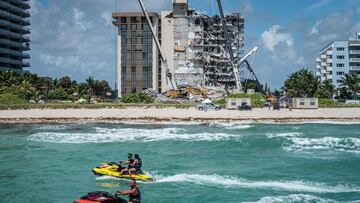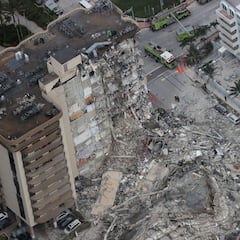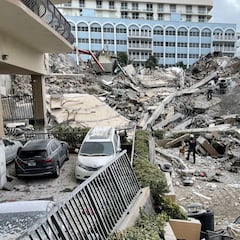What was the failure point in Miami condo collapse and why according to the investigations?
Preliminary evidence suggests that the structural failure initiated in the lower portion of the 13-story building that collapsed in Surfside, Florida.

In the early hours of Thursday morning, the Champlain Towers South, a 13-story condominium experienced a catastrophic structural failure reducing the building to a pile of debris. Ten victims have been recovered from the rubble and over 150 people are still unaccounted for. Structural damage was identified over three years ago and work to repair the damage was set to begin.
The building was due for a state-law required 40-year recertification, having been built in 1981, and was on notice that the repairs needed to be complete in order to pass inspection. A study in 2020 found that the building had been sinking at an alarming rate since the 1990s and experts are focusing on a spot in the lowest part of the complex as the initial point that set off the “progressive collapse.”
Also see:
- Over 159 people still missing after a Miami condo collapsed
- President Biden sends Federal support to Florida after Miami building collapse
- Miami building collapse: latest news
2018 report called for concrete deterioration “to be repaired in a timely fashion”
Nearly three years before the Champlain Towers South tragedy, a consultant Frank Morabito, who had inspected the structural integrity of the building, found evidence in the parking garage of “abundant” cracking and crumbling of varying degrees in the columns, beams and walls. The concrete slabs below the pool deck, entrance to the garage and planters were experiencing “major structural damage” with the rebar exposed in some locations.
A 2018 engineer’s report on the condo tower in Surfside, Florida, found problems in the parking level, including cracks columns and water damage. Some of the issues noted in the report are seen here, in italics. pic.twitter.com/G0k08zNP7x
— NYT Graphics (@nytgraphics) June 28, 2021
The October 2018 report said that “though some of this damage is minor, most of the concrete deterioration needs to be repaired in a timely fashion.” Failed waterproofing was causing the damage.
The report found that the waterproofing in those areas needed to be completely replaced having exceeded its life span. “Failure to replace the waterproofing in the near future will cause the extent of the concrete deterioration to expand exponentially,” the report reads.
Work was set to begin on the repairs after two and a half years, delayed by lengthy discussions by the condo association about the cost and the order in which the repairs needed to be done and then by the covid-19 pandemic. The Champlain Towers South Condominium Association had taken out a $12 million line of credit to pay for the repairs and work crews were beginning to make preparations to begin.
Land under building was sinking at an alarming rate
Related stories
A study to look at which parts of the Miami area are sinking, to identify where flooding and sea rise could impact the city the most, found an unusually high rate of subsidence at the Champlin Towers complex. The research performed by Shimon Wdowinski, a professor in the Department of Earth and Environment, and released in 2020, collected data form the 1990s which showed most of the Miami area barely sinking but in the area of the Champlin Towers complex it was "unusual."
During the 1990s the building was settling at a rate of about 2 millimeters per year, that subsidence could have slowed or accelerated with time according to Wdowinski. Although it doesn’t seem like much, over time he told USA Today that much sinking could have an impact on a building and its structure.


